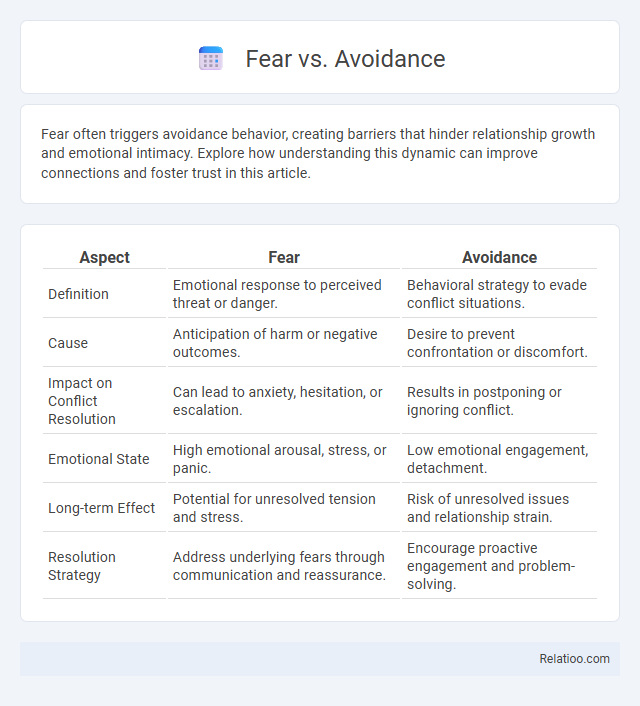Fear often triggers avoidance behavior, creating barriers that hinder relationship growth and emotional intimacy. Explore how understanding this dynamic can improve connections and foster trust in this article.
Table of Comparison
| Aspect | Fear | Avoidance |
|---|---|---|
| Definition | Emotional response to perceived threat or danger. | Behavioral strategy to evade conflict situations. |
| Cause | Anticipation of harm or negative outcomes. | Desire to prevent confrontation or discomfort. |
| Impact on Conflict Resolution | Can lead to anxiety, hesitation, or escalation. | Results in postponing or ignoring conflict. |
| Emotional State | High emotional arousal, stress, or panic. | Low emotional engagement, detachment. |
| Long-term Effect | Potential for unresolved tension and stress. | Risk of unresolved issues and relationship strain. |
| Resolution Strategy | Address underlying fears through communication and reassurance. | Encourage proactive engagement and problem-solving. |
Defining Fear: Understanding the Basics
Fear is an emotional response to a perceived threat, triggering your body's fight-or-flight mechanism to protect you from harm. Unlike avoidance, which is a behavioral action aimed at escaping fear-inducing situations, fear itself is the internal sensation signaling potential danger. Understanding the basics of fear helps distinguish it from avoidance behaviors and addresses the root of anxiety.
What is Avoidance? Core Concepts
Avoidance is a behavioral response where you deliberately steer clear of situations, objects, or activities that trigger fear or anxiety to reduce discomfort. It differs from fear, which is the emotional reaction, and avoidance serves as a coping mechanism that can reinforce anxiety by preventing exposure and habituation. Understanding avoidance is crucial for addressing anxiety disorders, as persistent avoidance can hinder recovery and maintain the cycle of fear.
Psychological Roots of Fear
Fear originates from the brain's amygdala, which processes threats and triggers survival responses, while avoidance behavior stems from the prefrontal cortex's regulation of fear by promoting escape or safety-seeking actions. Psychological roots of fear often trace back to past traumatic experiences, learned behaviors, and genetic predispositions influencing neural pathways. Understanding these elements clarifies how fear evolves into avoidance as a coping mechanism, reinforcing anxiety disorders and impacting emotional regulation.
The Mechanisms Behind Avoidance Behavior
Avoidance behavior is driven by the brain's fear response system, primarily involving the amygdala and prefrontal cortex, which processes perceived threats and triggers protective actions. This mechanism operates through negative reinforcement, where avoiding feared stimuli reduces anxiety temporarily, strengthening the avoidance cycle. Over time, this avoidance prevents habituation and extinction of fear memories, maintaining and potentially intensifying anxiety disorders.
Fear vs Avoidance: Key Differences
Fear is an emotional response triggered by perceived danger, activating the body's fight-or-flight mechanism, whereas avoidance is a behavioral strategy employed to escape or prevent exposure to feared stimuli. Fear serves as an internal signal to immediate threats, promoting survival, while avoidance can reinforce and perpetuate anxiety by limiting opportunities for habituation or desensitization. Understanding the distinction between fear as an emotional state and avoidance as a coping behavior is crucial in therapeutic approaches like cognitive-behavioral therapy (CBT) for anxiety disorders.
How Fear Fuels Avoidance
Fear triggers a survival response that fuels avoidance by signaling perceived threats, prompting Your brain to seek safety through retreat or escape. This avoidance, while temporarily reducing anxiety, reinforces the fear by preventing exposure to feared situations, creating a cycle that intensifies phobic reactions. Understanding this dynamic is essential for developing effective coping strategies and breaking the fear-avoidance loop.
Consequences of Chronic Avoidance
Chronic avoidance in response to fear can lead to increased anxiety, reduced coping skills, and impaired emotional regulation. Over time, this behavior reinforces the fear response, making it more intense and difficult to manage. Persistent avoidance also contributes to social isolation, diminished opportunities for personal growth, and a decline in overall mental health.
Effective Strategies to Manage Fear
Effective strategies to manage fear focus on distinguishing it from avoidance behaviors, as fear is an emotional response while avoidance reinforces anxiety patterns. Exposure therapy and cognitive-behavioral techniques help individuals confront fear directly, reducing its intensity and improving coping mechanisms. Mindfulness practices and controlled breathing also regulate physiological fear responses, promoting resilience and emotional regulation.
Overcoming Avoidance: Practical Approaches
Overcoming avoidance requires recognizing it as a behavioral response distinct from fear itself, where avoidance serves as a coping mechanism that reinforces anxiety. Your best approach involves gradually confronting feared situations through controlled exposure techniques, cognitive restructuring to challenge irrational thoughts, and building emotional resilience with mindfulness practices. Consistent practice helps retrain neural pathways, reducing avoidance and enabling you to regain control over anxiety and improve overall well-being.
Building Resilience: Embracing Fear, Facing Avoidance
Building resilience involves embracing fear as a natural response rather than an obstacle. Facing avoidance requires intentionally confronting fears to break the cycle of retreat and promote psychological growth. Developing emotional agility strengthens the ability to tolerate discomfort, ultimately enhancing adaptive coping mechanisms.

Infographic: Fear vs Avoidance
 relatioo.com
relatioo.com